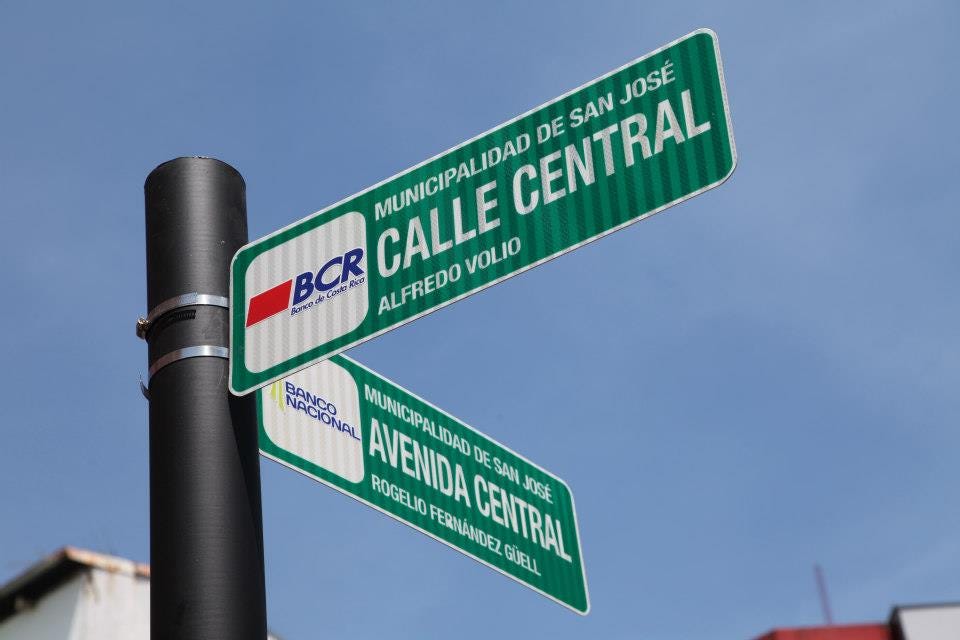Recommended listening: U2’s ‘Where The Streets Have No Name.’ While an appropriate soundtrack, the song was not inspired by Costa Rica. Sourcing for this article comes from Radio Ambulante’s ‘Perdido in San José,’ which we highly recommend if you speak Spanish.
Costa Rican uses an idiosyncratic system of addresses that relies on landmarks, history and quite a bit of guesswork.
My apartment, for instance, is three houses down from the local high school. The high school’s official address is 300 meters east of the elementary school. The elementary school’s address is across the street from the church — or next to the bar, depending on your piety.
Every address in Costa Rica is in relation to something else, and sometimes to things that no longer exist. Perhaps the best examples are the places identified by their relation to an antiguo higuerón — a fig tree that was felled long ago, but lives in perpetuity as a navigational waypoint.
Costa Rica’s address system is a cultural identity, albeit one that has provoked puzzled articles in international newspapers. It’s also frustrating most of the time, unless you’re well-versed in the history of every small town you visit. (Where exactly was the corn mill that closed 10 years ago, again?) And it’s occasionally dangerous, like when an ambulance gets lost following a subjective set of directions.
We’re more than 20 years into the 21st century, what gives?
Costa Rica does have streets with names or numbers. You can see them for yourself on Waze or Google Maps, but don’t expect most Costa Ricans to know they even exist.
San José used to have formal addresses that people actually used. Where did they go?
“I went to the Municipality of San José to ask, and they told me they didn’t know,” said Luis Fernando Vargas on Radio Ambulante. “I also asked at the National Registry to see if they had any ideas, but no — nothing.”
The explanation came from Geovanny Campos of Correos de Costa Rica, the company that manages the country's postal service. As he told Luis Fernando, San José’s growth was characterized by disorder. As the city expanded without following a pattern of rectangular city blocks, the established street numbers stopped making sense.
Eventually, nobody used them.
Costa Rica’s streets are in awful shape, traffic is terrible, and the addresses mean no one knows exactly where they’re going — so Ticos always have an excuse to be late.
That comes at a cost: A 2010 study found that informal addresses cost Costa Rica $720 million annually due to lost mail and lost productivity. And how many lives could be saved if ambulances (or police, or firefighters) were dispatched to precise locations?
Given the economic impact, authorities have tried pushing Costa Rica back toward using formal addresses. In 2006, some cantons began installing street signs. Costa Rica now has postal codes. But ask anyone their address, and you’re more likely to learn of an old tree than to hear a street name.
“One reason that changes are so tough to implement is that the old way is dearly beloved,” wrote author Katherine Stanley Obando. “It’s a language, an insider’s code.”
Isn’t there some beauty in how Costa Rican addresses mesh the past with the present? In a country that has modernized so quickly, an address connects what is with what once was.
The new burger chain isn’t just a restaurant that’s here now. It’s 100 meters from the soccer field, where we tore up our knees as kids. It’s next to the fig tree, the one that was cut down 20 years ago. It’s by the old market, which today is a parking lot.
It’s yesterday and today, the past and the present, all in an address.
Stories like this can only exist with your support. Thank you for allowing us to share our passion with you:
